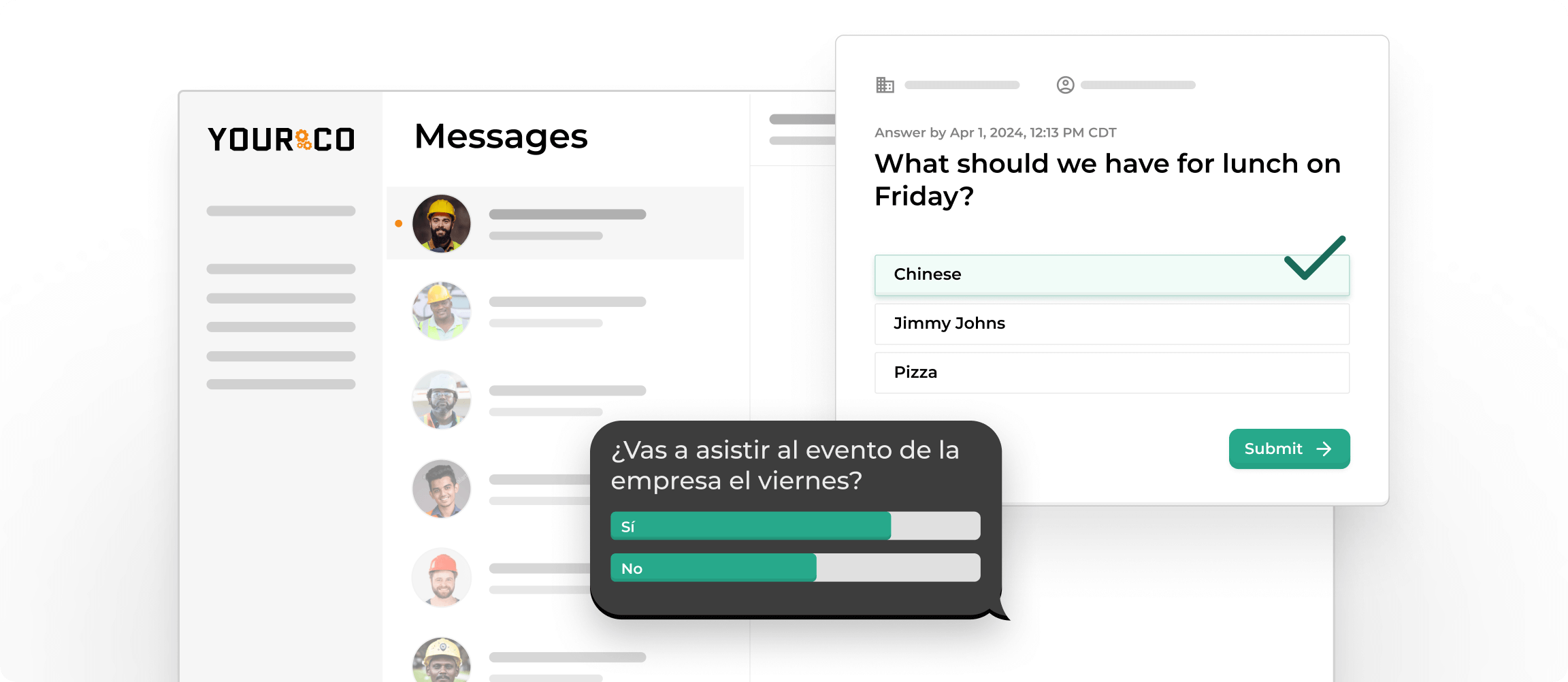How Can I Track Employee Engagement in My Manufacturing Facility?


Your morning walk through the plant can reveal more than production numbers. You notice quiet conversations, tired faces, and a sense that people are just getting through the day. Low engagement in manufacturing often starts this way, and it’s usually because workers feel out of the loop or unheard. Over time, that silence grows into higher turnover, safety risks, and missed targets. This guide gives you clear steps to spot early warning signs, rebuild communication, and strengthen engagement across every shift.
→ Download the Free Engagement Survey Template to launch your next pulse check in minutes. Includes ready-to-use questions, follow-up steps, and a mobile-friendly layout.
Measure Engagement with Quick Feedback Tools
Quick pulse surveys give you a real-time read on how your team feels, unlike long annual surveys that surface problems months too late.
Traditional engagement surveys happen once a year and take weeks to complete. By the time you get results and plan changes, your team has moved on or people have quit. Short, frequent check-ins that take under a minute to complete work better because they meet workers where they are. Employees can answer during break or right after clocking out, so you get honest feedback when it matters. Keep surveys to two to three questions max.
Design your pulse surveys with these practical elements in mind:
- Ask simple, concrete questions that connect to daily work like "Do you have the tools you need to work safely today?" or "Is this week's production goal realistic?"
- Use yes/no answers or a 1-5 scale with one optional comment box for extra context
- Always keep responses anonymous so people trust their answers can't be traced back to them
- Track results by shift and department so you can spot differences between day and night crews
- Send surveys once every week or two at the end of shifts when machines are off and workers have time to think
Most importantly, always share what you learned and what you're doing about it. When employees see you act on their feedback, they keep giving it.
Keep Workers Informed About Daily Operations
Clear, steady updates keep your shop floor running smoothly. When everyone knows the day's goals, safety steps, and policy changes, mistakes drop and morale rises.
Email and company websites won't reach most of your team, and many frontline employees don't have corporate email access. That communication gap creates confusion and lets rumors spread. Text messages work differently, reaching a 95% read rate within 90 seconds, so your updates get seen. Combine texts with quick shift huddles and digital boards. Every worker stays informed, no matter where they are or what device they use.
Focus your daily communications on information that drives results:
- Safety reminders that protect your team from injuries and incidents
- Production targets that give workers clear goals for each shift
- Quality alerts that help prevent defects before they multiply
- Policy updates that keep everyone aligned with current procedures
Send information as soon as it changes instead of saving it for the weekly meeting. Being upfront about missed goals or equipment problems shows respect and builds trust with your team.
Different shifts need the same information at different times. A simple daily rhythm works well: a 5 a.m. text with today's production goal, a mid-shift huddle covering safety points, hourly updates on digital boards showing progress, and a Friday afternoon recap with team wins. When you share information quickly across multiple channels, you eliminate guesswork and help people focus on hitting the next target.
Recognize and Celebrate Contributions
When you recognize good work, morale improves and production lines run smoother. Workers who feel valued tend to be highly engaged, which shows up in fewer mistakes and lower turnover on the shop floor.
Start by tying recognition to outcomes that matter in manufacturing. A "zero-injury month" banner, a shout-out for a flawless first-pass yield, or a shift-wide celebration when a daily target gets hit all turn abstract KPIs into personal wins. Publicly recording a team's safety streak or quality score on the scoreboards every crew can see reinforces that success is everyone's job.
Build a recognition system that fits naturally into your shop floor routine:
- Kick off each shift with a quick announcement of yesterday's top performer
- Leave handwritten "thank you" notes at workstations for specific achievements
- Send quick messages to the entire line when someone suggests a process improvement that saves time
- Create a text-in system where employees nominate coworkers for going above and beyond
- Track who gets recognized by shift, role, and department to ensure fairness across all teams
These moments cost nothing, yet they make an impact because they happen during work rather than at a distant awards dinner.
Encourage peers to notice each other, not just managers. Because nominations come from the floor, every shift and language group gets a fair shot at being recognized, countering the perception that only day-shift or English-speaking teams get the spotlight.
Simple recognition works well in manufacturing environments: a traveling trophy for cleanest workstation, a pizza lunch when uptime hits a weekly record, or a "Safety Champion" hard-hat sticker that workers wear with pride.
Create Two-Way Channels for Feedback
Healthy engagement needs to be back-and-forth. When workers can speak up easily, you spot issues sooner and build trust faster.
Give teams multiple ways to share their thoughts that fit naturally into their workday:
- Set up a text-based suggestion line to encourage sharing ideas during breaks without hunting for a kiosk or office computer
- Place a physical drop box near the time clock for anyone who prefers pen and paper
- Post QR codes on every machine that open a one-question hazard form with no login required
- Offer prompts and instructions in every common language on the floor
- Use tools that auto-translate replies so supervisors can read them instantly
Each tool should promise anonymity, since people only share honest feedback when they know their badge number isn't attached.
Quick follow-up builds real trust. Commit to replying within a shift or posting weekly "You said, we did" boards that highlight actions taken. You don't need fancy tech. Just clear, inclusive channels and a promise to act on what you learn.
Track Engagement Trends and Act on Them
Watch the signals that reveal how your people feel day to day. Keep an eye on three basics: how many workers answer each pulse survey, how often they volunteer ideas or concerns, and which topics keep popping up.
Focus on metrics that reveal engagement problems before they escalate:
- Survey participation rates that show which crews are tuning out
- Volume of open-ended comments that indicate how much workers trust you
- Recognition shout-outs logged each week that reveal team morale
- Response rate dips that signal something needs attention on specific crews
When response rates fall below normal, treat it like an early warning light on a machine.
Patterns matter more than single data points. Compare night-shift feedback to day crew responses, or check if one line's recognition numbers lag behind another's. Consistent gaps usually point to coaching needs, staffing problems, or workflow issues.
Keep in mind that the numbers only build trust when you act on them. Share a quick summary of what you learned, outline one concrete step you'll take, and set a date to report progress. This connects engagement tracking to outcomes you already measure, like fewer safety incidents, cleaner quality audits, and steadier productivity. Over time, workers see that speaking up leads to real change, and your engagement numbers start improving naturally.
Connect Your Entire Team with Yourco
Yourco puts critical messages directly in workers' pockets within seconds, ensuring every shift stays connected through powerful two-way communication. Quick check-ins become simple with text-based surveys sent straight to each worker's phone. You can track morale shift by shift and gather fresh ideas in real time.
Employees reply in their preferred language, and built-in AI translations (supporting over 135 languages and dialects) turn every response into clear, actionable feedback without needing bilingual supervisors on every shift. This means your Spanish-speaking night crew and your English-speaking day team both get heard equally, eliminating the communication barriers that often silence valuable frontline insights.
Daily updates reach workers instantly. Shift changes, safety alerts, and policy reminders arrive by text the moment you send them, not when someone finally checks the bulletin board. Since messages work on basic flip phones without apps or Wi-Fi, busy production lines and contract crews stay informed regardless of their device. No downloads, no passwords, no excuses. Just immediate, reliable communication that meets workers where they are.
Yourco logs every survey and message in searchable dashboards that show you what matters most. You see response rates, trends, and problem areas at a glance, helping you pinpoint where recognition, training, or extra staffing will make the biggest difference.
Ready to give your shop floor a stronger voice? Try Yourco for free today or schedule a demo and see the difference the right workplace communication solution can make in your company.
Frequently Asked Questions
How often should I run pulse surveys in a manufacturing facility?
Weekly or bi-weekly works best for manufacturing teams. Keep surveys short, just 2-3 questions, so workers can respond quickly between tasks. Frequent check-ins help you catch problems early and show participation trends you can act on before issues get worse.
What are simple ways to recognize employees on the shop floor?
Start with public recognition during shift changes. Call out safety milestones, quality wins, or helpful suggestions right at the time clock or during brief team huddles. Even a 30-second acknowledgment makes workers feel valued and boosts team morale.
How do I keep multilingual teams equally engaged?
Send every message in each worker's preferred language. Capture language preferences when people start, then use that choice for all surveys, alerts, and updates. Visual aids and simple translations remove confusion and help everyone stay safe and informed. With Yourco, you can send text messages to over 135 languages and dialects, ensuring you reach every employee in the words they understand.
What signs show engagement is slipping in a facility?
Watch for more call-outs, production errors, and safety incidents. Lower response rates to surveys or fewer improvement suggestions also signal trouble. When workers stop participating or sharing ideas, it usually means trust and communication have broken down.
What types of updates should I share regularly to maintain engagement?
Focus on information that affects the current shift: safety reminders, production targets, quality updates, and schedule changes. Real-time alerts work better than bulletin boards because workers get the information when they need it, not hours later.




